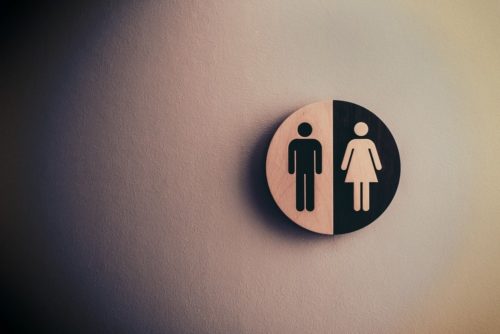
Photo provided courtesy of Unsplash.com
By Kirstin Kennedy, Staff Writer
It’s impossible for consumers to deny the use of marketing techniques implemented in the layout of department stores, particularly in aisles designated for children. That’s why it was shocking to many in late 2015 when the department store Target made a decision to go “gender neutral” in its children’s toys, entertainment, and bedding departments. [1] While aisles are still segregated – some stocked from floor to ceiling with boxes of blonde Barbies dolls in pink bikinis and others with extra-large plastic dump trucks and Legos figurines dressed in blue, black, and green – the store removed the categorization: signage indicating that the aisle was for girls or boys. [2]
At the time it announced the decision, Target cited customer suggestions as the driving force behind its choice to remove the word “boy” from the aisle with the toy cars and the word “girl” from that with the pink princess comforters. [3] Further, the store removed gender-classifying coloring from the aisles, like blue wallpapering behind the products in what was once known as the boys’ section. [4]
However, reactions to the decision was mixed. [5] Some cited this move by the nation’s second largest retailer as a gesture toward gender inclusivity, others criticized the decision for its reduction of social norms, and others, still, called the choice a mere marketing ploy. [6] Regardless of the reasons, the retailer followed through with the proposal and removed gender signage from its stores across the United States. [7]
Now, a proposal in the State of California may take Target’s gender neutral display idea even further. [8] A recent bill introduced in the California Legislature would make it illegal for stores to segregate goods based on gender. [9] The bill, which was brought by California legislator Evan Low (D-Silicon Valley), proposed a fine to stores that separate girls and boys items up to $1,000 for each infraction. [10] Instead, stores would be required to place childcare products in an “undivided area,” displayed as gender neutral. [11] In the bill itself, Low explained that the motivation behind the proposal is to dismiss marketing techniques in favor of easing the effort for consumers to compare similar products, particularly those products associated with child care. [12]
In a statement released by Low, the Democrat said that he was inspired to introduce the bill after the eight-year-old daughter of one of his staffers suggested to him that stores should not decide whether a shirt is meant to be worn by boy or a girl. [13] Low further stated that segregation of such products serves to “pigeonhole children” and leads to stigmatization based on their individual choices – anyone child can wear a shark hoodie or play with a doll. [14] Low stated in a press release, “We need to let kids be kids.” [15]
Notably, mom-and-pop toy shops need not comply, as the bill only targets retailers with 500 or more employees. [16] Dubbed AB 2826, Low’s bill is currently pending referral to committee. [17] If passed, it would go not into effect until 2023. [18] The idea isn’t just related to Target’s 2015 move to reduce gender signage in its stores. In addition to the department store, other retailers have made moves to reduce gender classification, including both Abercrombie & Fitch and John Lewis, which introduced gender neutral clothing lines for children. [19] The trend goes hand-in-hand with recent proposals to ban what is known as the “pink tax,” meaning the discriminatory pricing on products that are necessary for women, such as feminine hygiene products and goods used for nursing. [20] Further, several brands have recently originated with the exclusive goal of marketing gender neutral clothing and products. [21]
Despite this trend, there is distinction between a company’s choice to include unisex options for consumers and a bill mandating gender neutral marketing in large department stores. While the vote is ultimately up to the California Legislature, whether or not other states follow this trend is up to consumers. For example, in reaction to AB 2826, one California resident expressed disappointment in the potential for a state law to restrict her ability to raise and dress her children by the gender they were assigned at birth. [22] Conversely, another touted the move as one that would prevent her from running around an entire department store in order to shop for her small children – one a girl, one a boy. [23]
[1] https://www.usatoday.com/story/news/nation-now/2015/08/09/target-remove-gender-based-labeling/31375863/
[2] Id.
[3] Id.
[4] Id.
[5] https://www.washingtonpost.com/posteverything/wp/2015/08/13/target-will-stop-selling-toys-for-boys-or-for-girls-good/
[6] Id.
[7] https://corporate.target.com/article/2015/08/gender-based-signs-corporate
[8] https://sacramento.cbslocal.com/2020/02/26/gender-neutral-toy-aisles-california-bill/
[9] Id.
[10] Id.
[11] Id.
[12] Id.
[13]https://a28.asmdc.org/press-releases/20200226-let-kids-be-kids-assemblymember-low-expands-gender-neutral-retail; https://www.sacbee.com/news/politics-government/capitol-alert/article240601601.html
[14] Id.
[15] Id.
[16] https://sacramento.cbslocal.com/2020/02/26/gender-neutral-toy-aisles-california-bill/
[17]https://a28.asmdc.org/press-releases/20200226-let-kids-be-kids-assemblymember-low-expands-gender-neutral-retail
[18] https://www.sacbee.com/news/politics-government/capitol-alert/article240601601.html
[19]https://a28.asmdc.org/press-releases/20200226-let-kids-be-kids-assemblymember-low-expands-gender-neutral-retail
[20] https://axthepinktax.com/#education
[21] https://www.hercampus.com/style/gender-neutral-clothing-brands
[22]https://www.washingtonexaminer.com/news/let-kids-be-kids-california-bill-would-require-stores-to-feature-gender-neutral-sections-for-childrens-goods
[23] Id.